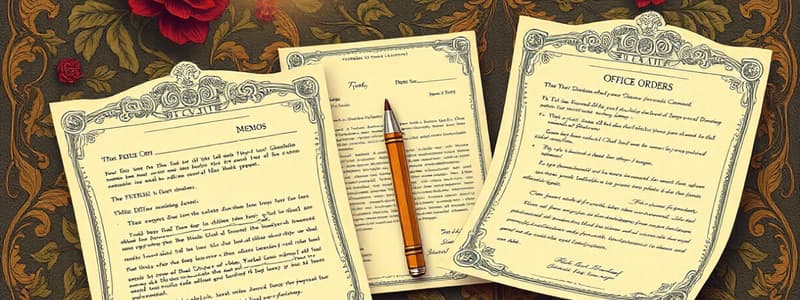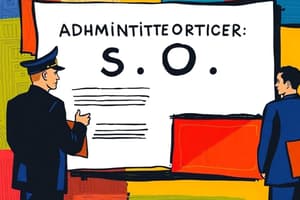Podcast
Questions and Answers
What is the primary direction of communication for an office order?
What is the primary direction of communication for an office order?
- Downward, from authority to subordinates (correct)
- Upward, from subordinates to superiors
- Lateral, between colleagues of the same rank
- Diagonal, across different departments and ranks
Which of the following is NOT typically included in the header information of an office order?
Which of the following is NOT typically included in the header information of an office order?
- Date of issuance
- Organization logo and name
- Office order number
- Employee contact information (correct)
What should an office order's subject line clearly state?
What should an office order's subject line clearly state?
- The purpose of the office order (correct)
- The recipient's name and designation
- The legal basis for the order
- A summary of previous orders
What is the recommended writing style for the body of an office order?
What is the recommended writing style for the body of an office order?
What aspect of legal compliance is most important when drafting an office order?
What aspect of legal compliance is most important when drafting an office order?
What should the 'implementation date' section of an office order specify?
What should the 'implementation date' section of an office order specify?
What potential consequence should be clearly stated within the 'compliance expectations' section of an office order?
What potential consequence should be clearly stated within the 'compliance expectations' section of an office order?
Besides clarity and formal tone, what else should be ensured when drafting an office order?
Besides clarity and formal tone, what else should be ensured when drafting an office order?
Which guideline should be followed when drafting a circular for a large audience?
Which guideline should be followed when drafting a circular for a large audience?
What is the primary purpose of an office memo?
What is the primary purpose of an office memo?
Which of the following scenarios is most appropriate for using an office memo?
Which of the following scenarios is most appropriate for using an office memo?
Which element is a standard component of an office memo's heading?
Which element is a standard component of an office memo's heading?
What is the most appropriate tone to use in an office memo?
What is the most appropriate tone to use in an office memo?
Which of the following actions would NOT typically be initiated through an office memo?
Which of the following actions would NOT typically be initiated through an office memo?
An office memo can serve as a written record of what?
An office memo can serve as a written record of what?
Why is it important for a circular to be properly signed by an authority?
Why is it important for a circular to be properly signed by an authority?
Which type of business meeting primarily focuses on the review of a company's financial health, policy setting, and strategic direction?
Which type of business meeting primarily focuses on the review of a company's financial health, policy setting, and strategic direction?
What is the primary purpose of including a 'Meeting Objective/Goal' in a business meeting agenda?
What is the primary purpose of including a 'Meeting Objective/Goal' in a business meeting agenda?
In the context of business meetings, what does 'collaboration' primarily facilitate?
In the context of business meetings, what does 'collaboration' primarily facilitate?
Besides enhancing decision-making, what outcome is fostered when business meetings encourage relationship-building?
Besides enhancing decision-making, what outcome is fostered when business meetings encourage relationship-building?
Which component of a business meeting agenda helps participants prepare by providing necessary context?
Which component of a business meeting agenda helps participants prepare by providing necessary context?
If there is a need to set goals, outline strategies, and map out future actions, which type of business meeting is most suitable for this purpose?
If there is a need to set goals, outline strategies, and map out future actions, which type of business meeting is most suitable for this purpose?
What is the purpose of including the 'person responsible for each item' on a business meeting agenda?
What is the purpose of including the 'person responsible for each item' on a business meeting agenda?
For which objective would a business primarily conduct sales meetings?
For which objective would a business primarily conduct sales meetings?
Which of the following is the MOST important characteristic of an effective office memo?
Which of the following is the MOST important characteristic of an effective office memo?
What is the recommended action to take before sending out a memo?
What is the recommended action to take before sending out a memo?
In an office memo, where should any required actions, deadlines, or necessary follow-up be stated?
In an office memo, where should any required actions, deadlines, or necessary follow-up be stated?
What is the PRIMARY purpose of a business meeting?
What is the PRIMARY purpose of a business meeting?
Which of the following business meeting types is mentioned in the text?
Which of the following business meeting types is mentioned in the text?
According to the memo example, from whom should employees seek clarification regarding the work-from-home policy?
According to the memo example, from whom should employees seek clarification regarding the work-from-home policy?
What is the suggested formatting to include on the details section of a memo?
What is the suggested formatting to include on the details section of a memo?
When stating actions in the conclusion or action required section of the memo, what details need to be included?
When stating actions in the conclusion or action required section of the memo, what details need to be included?
Which of the following best describes the primary purpose of report writing?
Which of the following best describes the primary purpose of report writing?
Why is record keeping an important aspect of report writing?
Why is record keeping an important aspect of report writing?
Which type of corporate report primarily focuses on a company's environmental, social, and governance (ESG) initiatives?
Which type of corporate report primarily focuses on a company's environmental, social, and governance (ESG) initiatives?
What is the role of external auditors in the context of an audit report?
What is the role of external auditors in the context of an audit report?
Which report contains financial statements, achievements, and future outlook?
Which report contains financial statements, achievements, and future outlook?
What is the main objective of an auditor's report?
What is the main objective of an auditor's report?
Which of the following is NOT a typical component of corporate reports?
Which of the following is NOT a typical component of corporate reports?
How does report writing contribute to accountability within an organization?
How does report writing contribute to accountability within an organization?
Which type of auditor's report indicates that financial statements are materially misstated and do not accurately represent the company's financial position?
Which type of auditor's report indicates that financial statements are materially misstated and do not accurately represent the company's financial position?
What is the primary significance of an auditor's report for potential investors?
What is the primary significance of an auditor's report for potential investors?
An auditor issues a 'Disclaimer of Opinion' when:
An auditor issues a 'Disclaimer of Opinion' when:
Which objective of report writing is most concerned with converting data into understandable insights?
Which objective of report writing is most concerned with converting data into understandable insights?
Which type of opinion is issued when the auditor believes the financial statements are, overall, fairly presented, despite a few specific exceptions?
Which type of opinion is issued when the auditor believes the financial statements are, overall, fairly presented, despite a few specific exceptions?
For a company, what is the role of an auditor's report in ensuring regulatory compliance?
For a company, what is the role of an auditor's report in ensuring regulatory compliance?
When a report aims to change the audience's perspective or actions through supporting facts and reasoning, it primarily serves which objective?
When a report aims to change the audience's perspective or actions through supporting facts and reasoning, it primarily serves which objective?
Beyond verifying accuracy, what broader benefit does an auditor's report provide to a company's stakeholders?
Beyond verifying accuracy, what broader benefit does an auditor's report provide to a company's stakeholders?
Flashcards
Header Information
Header Information
Basic elements at the top of an office order, including logo, order number, date, and issuing authority.
Subject Line
Subject Line
A clear statement indicating the main purpose of the office order.
Body of the Order
Body of the Order
The main section detailing the reason, specific instructions, implementation date, and compliance expectations.
Clarity and Conciseness
Clarity and Conciseness
Signup and view all the flashcards
Formal Tone
Formal Tone
Signup and view all the flashcards
Compliance Expectations
Compliance Expectations
Signup and view all the flashcards
Proper Dissemination
Proper Dissemination
Signup and view all the flashcards
Downward Communication
Downward Communication
Signup and view all the flashcards
Circular
Circular
Signup and view all the flashcards
Office Memo
Office Memo
Signup and view all the flashcards
Purpose of Memos
Purpose of Memos
Signup and view all the flashcards
Structure of a Memo
Structure of a Memo
Signup and view all the flashcards
Heading/Title in a Memo
Heading/Title in a Memo
Signup and view all the flashcards
Use of Memos for Policies
Use of Memos for Policies
Signup and view all the flashcards
Request for Action in Memos
Request for Action in Memos
Signup and view all the flashcards
Body of the Memo
Body of the Memo
Signup and view all the flashcards
Details in Memo
Details in Memo
Signup and view all the flashcards
Conclusion in Memo
Conclusion in Memo
Signup and view all the flashcards
Effective Memo Tip: Clarity
Effective Memo Tip: Clarity
Signup and view all the flashcards
Effective Memo Tip: Bullet Points
Effective Memo Tip: Bullet Points
Signup and view all the flashcards
Professional Tone in Memos
Professional Tone in Memos
Signup and view all the flashcards
Proofreading Memos
Proofreading Memos
Signup and view all the flashcards
Business Meeting Definition
Business Meeting Definition
Signup and view all the flashcards
Report Writing
Report Writing
Signup and view all the flashcards
Importance of Report Writing
Importance of Report Writing
Signup and view all the flashcards
Corporate Report
Corporate Report
Signup and view all the flashcards
Annual Report
Annual Report
Signup and view all the flashcards
Financial Report
Financial Report
Signup and view all the flashcards
Sustainability Report
Sustainability Report
Signup and view all the flashcards
Management Report
Management Report
Signup and view all the flashcards
Auditor's Report
Auditor's Report
Signup and view all the flashcards
Client Meetings
Client Meetings
Signup and view all the flashcards
Board Meetings
Board Meetings
Signup and view all the flashcards
Staff Meetings
Staff Meetings
Signup and view all the flashcards
Sales Meetings
Sales Meetings
Signup and view all the flashcards
Annual General Meetings (AGM)
Annual General Meetings (AGM)
Signup and view all the flashcards
Importance of Meetings
Importance of Meetings
Signup and view all the flashcards
Business Meeting Agenda
Business Meeting Agenda
Signup and view all the flashcards
Key Components of Agenda
Key Components of Agenda
Signup and view all the flashcards
Unqualified Opinion
Unqualified Opinion
Signup and view all the flashcards
Qualified Opinion
Qualified Opinion
Signup and view all the flashcards
Adverse Opinion
Adverse Opinion
Signup and view all the flashcards
Disclaimer of Opinion
Disclaimer of Opinion
Signup and view all the flashcards
Importance of Auditor's Report
Importance of Auditor's Report
Signup and view all the flashcards
Objectives of Report Writing
Objectives of Report Writing
Signup and view all the flashcards
Informing
Informing
Signup and view all the flashcards
Analyzing
Analyzing
Signup and view all the flashcards
Study Notes
Departmental Communication
- Office orders are formal written communications used to convey instructions and decisions to employees.
- They are essentially top-down communication tools used to enforce policies or implement changes for specific actions within a company.
- Office orders are typically drafted in clear and concise language, specifying details, who the order applies to, and the compliance deadline.
- The order is signed by a designated authority figure within the company.
Key Uses of an Office Order
- Personnel Changes: Announcing promotions, transfers, new hires, or employee reassignments.
- Policy Updates: Communicating changes to policies, such as work hours, dress code, leave policies, or safety procedures.
- Disciplinary Actions: Issuing warnings or taking disciplinary actions against employees for violating company rules.
- Important Announcements: Sharing important information like upcoming deadlines, training schedules, or special events.
- Clarifying Procedures: Providing detailed instructions for specific tasks or processes to maintain consistent implementation.
Drafting an Office Order
- Header Information: Includes organization logo, office order number, date of issuance, issuing authority (name and designation), and subject line.
- Subject Line: Clearly states the purpose of the order.
- Body of the Order:
- Introduction: Briefly explains the reason for the order.
- Details: Clearly explains the specific instructions, policy changes, or required actions.
- Implementation Date: Specifies the date the order takes effect.
Important Points for Drafting an Office Order
- Use clear and concise language to avoid ambiguity.
- Maintain a professional and authoritative writing style.
- Ensure the order complies with company policies and relevant employment laws.
- Distribute the order to all affected employees through appropriate channels.
Office Circulars
- Office circulars are formal written documents used to disseminate important information to all employees in an organization.
- They typically announce new policies, procedures, updates, or events.
- Circulars are aimed at a large audience simultaneously.
- Circulars usually include a heading with the company logo, date, a subject line, a detailed body of information, and a signature of the issuing authority.
Drafting an Office Circular
- Start with a clear subject line: Briefly state the main topic of the circular to capture attention.
- Address the recipient appropriately: Begin with a salutation like "To all employees" or "Dear staff".
- Clearly state the purpose: Explain the reason and key information being communicated.
- Use concise and plain language: Avoid jargon and complex sentences.
- Provide necessary details: Include specific dates, deadlines, procedures, or contact information.
- Conclude with a call to action (if required): Instruct employees on the required action after reading.
Signature and Contact Information
- Sign the circular with the authorized person's name and title.
- Provide contact details for inquiries.
Office Memo
- Short for memorandum, it's a brief, formal internal communication document used within a business or organization.
- Used for quick and clear communication of important information to a specific audience within the organization.
Uses of Office Memos
- Communicating policies, changes in rules, or company-wide updates.
Instructions and Procedures
- Detailed instructions regarding processes, procedures, or protocols within an office.
- Meeting invitations and announcements.
- Requests for action (e.g., submitting reports, confirming attendance).
- Clarifications or reminders.
Structure and Drafting of an Office Memo
- The heading should include the word "Memo" or "Memorandum".
- The "To", "From", "Date", and "Subject" lines provide clear identification.
- The body of the memo contains the message, broken down into sections including Introduction, Details, and Conclusion/Action Required.
- Use clear and concise language, bullet points, and a professional tone.
Meeting Minutes
- Written record of a meeting's proceedings, decisions, tasks assigned, and deadlines.
- Factual account of discussions, decisions, action items, and deadlines.
Meeting Minutes Summary
- Summarizes discussions, decisions, action items, and the person responsible for each action item.
- Important for recording decisions, assigned tasks, and agreed-upon deadlines.
- Helps attendees remember what happened.
Report Writing
- Reports are structured documents that present information on a specific topic.
- Reports often include an introduction, methodology, findings, conclusions, and recommendations.
- Reports are useful tools for conveying complex issues clearly.
Importance of Report Writing
- Informative: Reports help understand the subject matter thoroughly.
- Analytical: Reports often include data analysis, to help break down complex information.
- Documentation: Reports act as official records of discussions, decisions, or activities.
- Accountability: Ensures that actions and decisions are documented and traceable.
- Professionalism: Well-written reports show professionalism.
Corporate Reports
- Formal documents about a company's activities, financial performance, and strategies.
- Often shared with stakeholders like investors, employees, and regulatory bodies.
Types of Corporate Reports
- Annual Reports: Yearly publications summarizing financial performance.
- Financial Reports: Focus on company finances (income statement, balance sheet).
- Sustainability/CSR Reports: Outline environmental, social, and governance initiatives.
- Management Reports: Reviewing operational highlights.
- Audit Reports: Formal reviews of financial records by external auditors.
Auditor's Reports
- Prepared by independent auditors after reviewing company financial records.
- Assess the accuracy, fairness, and compliance of financial statements with accounting standards.
- Help ensure the accuracy and compliance of financial statements.
Types of Auditor's Reports
- Unqualified Opinion: Financial statements are accurate, free of material misstatements.
- Qualified Opinion: Accurate except for certain specified exceptions.
- Adverse Opinion: Indicates that financial statements are materially misstated.
- Disclaimer of Opinion: Auditor unable to form an opinion due to scope limitations.
Importance of Auditor's Reports
- Transparency and Trust: Independent reviews build trust for stakeholders.
- Regulatory Compliance: Ensures compliance with financial reporting standards.
- Investment Decision: Helps investors make informed decisions.
- Risk Management: Identifies operational and financial risks.
Studying That Suits You
Use AI to generate personalized quizzes and flashcards to suit your learning preferences.




